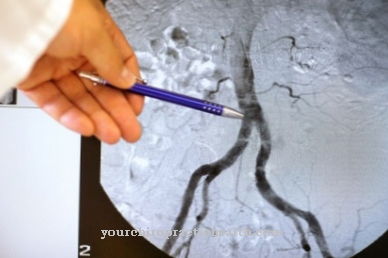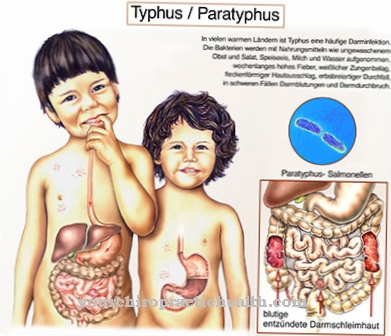At the Reye syndrome, named after the Australian pediatrician Ralph Douglas Reye, is an acute metabolic disease that is associated with damage to the brain and liver. Reye's syndrome primarily affects children.
What is Reye's Syndrome?

© Kaspars Grinvalds - stock.adobe.com
The Reye syndrome usually occurs as a result of a previous viral infection, in particular flu or chickenpox. About a week after the actual illness has subsided, there is severe and frequent vomiting and a high fever.
The children often appear restless, sometimes even hyperactive and easily irritable. The blood sugar level can drop sharply. In severe and advanced cases, seizures, spasticity, clouding of consciousness and unconsciousness up to coma can occur. Around two thirds of patients with severe forms of disease suffer from edema in the brain.
In principle, Reye's syndrome can occur at any age; however, mostly children between four and twelve years of age are affected. The disease occurs indiscriminately in girls and boys. Reye's syndrome is an extremely rare disease, but it can have serious consequences and urgently requires medical treatment.
causes
At the Reye syndrome This leads to damage to the mitochondria, which in turn affects the metabolism of certain organs. As a result, the body becomes too acidic and ammonia and fatty acids accumulate in the liver, which can lead to liver failure.
The accumulation of ammonia can lead to the formation of brain edema. Although the exact cause of Reye's syndrome is not known, it has been seen more frequently in cases where patients with viral infections were treated with drugs containing acetylsalicylic acid. Since this connection became known, a general decline in Reye's syndrome has been recorded through appropriately adapted therapy recommendations.
The exact connection between acetylsalicylic acid and Reye's syndrome has not yet been clarified; a genetic disposition is suspected. In children under two years of age who develop Reye's syndrome, a congenital metabolic disorder is usually assumed to be the cause.
Symptoms, ailments & signs
Reye's syndrome is a malfunction of the cellular apparatus. The disease mostly only occurs in children and adolescents. Mainly the liver and the brain are attacked. Reye's syndrome can be fatal. Investigations into the causes are still ongoing.
Scientists assume that the causative agents of the flu or chickenpox can be just as responsible as certain drugs. Reye's syndrome occurs in association with resolving viral infections. The first sign of this is frequent vomiting. Nausea, on the other hand, does not occur. The little patients appear restless and confused, powerless and hardly responsive.
Seizures are also typical of the disease. It is not uncommon for patients to fall into a coma. The accumulation of fluid leads to increased intracranial pressure. This affects important nerve tracts. It also leads to fatty liver disease.
The associated dysfunction can lead to various impairments of the metabolism. One indication is, for example, hypoglycaemia. The skin often turns yellow. After a blood sample is taken, the blood clotting time will be prolonged. The symptoms are similar to blood poisoning or meningitis and are therefore not easy to differentiate without a detailed examination.
Diagnosis & course
Since that Reye syndrome It is extremely rare - around 50 cases are assumed in the USA each year - it is often not recognized. The symptoms are also relatively unspecific and are often misinterpreted and misdiagnosed as meningitis or a congenital metabolic disorder.
The diagnosis can be made using blood and urine tests. This shows increased liver enzymes, blood clotting disorders, an increased concentration of ammonia and, often, a blood sugar level that is too low. Imaging procedures or a liver biopsy are used to confirm the diagnosis, in which changes in the mitochondria and obesity of the liver are determined.
The increase in cerebral pressure can be demonstrated on the basis of the brain waves. Anamnestically, the previous intake of acetylsalicylic acid-containing drugs in the case of a viral infection is also important.
If left untreated, Reye's syndrome is a life-threatening disease that is fatal in around a quarter of cases. About 30% of patients suffer neurological sequelae such as language or learning problems. Reye's syndrome is not contagious.
Complications
Reye's syndrome itself is a very serious complication of a viral infection and usually affects children between the ages of four and ten years. In up to 50 percent of all cases, patients die of severe complications that particularly affect the brain and liver. Unfortunately there is no curative therapy.
Treatment is simply to relieve the severe symptoms in order to ensure the survival of those affected. In many cases where the children have survived, neurological disorders remain, which result from brain damage. This means that paralysis, language disorders or mental limitations can persist for life. The main hallmarks of Reye's syndrome are liver and brain damage. The liver develops into fatty liver, which is severely restricted in its function.
Ultimately, liver failure can even occur, which in severe cases also necessitates a liver transplant. Since the functions of the liver and kidneys are closely linked, kidney damage or even kidney failure can occur. At the same time, the brain is affected. The pressure in the brain increases due to the accumulation of fluid (cerebral edema).
Brain edema is responsible for the most serious complications of Reye's syndrome. About 60 percent of the affected children develop the full picture of Reye's syndrome, which, in addition to liver dysfunction, is also characterized by confusion, irritability, seizures and impaired consciousness up to coma. Three quarters of those with fully developed Reye's syndrome do not survive the disease.
When should you go to the doctor?
Reye's syndrome should always be evaluated and treated by a doctor. This disease does not usually self-heal. Since the condition is a genetic disease, it cannot be completely cured. However, the person affected is also entitled to genetic counseling so that Reye's syndrome is not passed on to the next generation.
A doctor should be consulted if the person concerned suffers from severe nausea or even vomiting over a long period of time. The patients are often confused or barely accessible and cannot communicate with other people. Persistent hypoglycaemia can also indicate Reye's syndrome and should be investigated. In the worst case, if Reye's syndrome is untreated, the affected person can suffer from blood poisoning or inflammation of the meninges, which can also be fatal. First and foremost, a general practitioner should be consulted with the complaints. Further treatment is carried out by a specialist.
Treatment & Therapy
There is no specific, causal therapy for that Reye syndrome. Treatment is limited to the alleviation of acute symptoms and damage limitation with regard to severe forms such as liver failure or coma.
This requires intensive medical inpatient treatment under close medical care. The supply of liquid and nutrients can be ensured through a cannula. If necessary, the intracranial pressure is lowered by specific drugs. In some cases, the patient needs artificial respiration.
Reye's syndrome is a medical emergency. If this disease is suspected, medical help should be sought as soon as possible, as prompt medical intervention can prevent the disease from progressing and thus reduce the risk of consequential damage.
You can find your medication here
➔ Medicines against vomiting and nauseaprevention
The the Reye syndrome has been observed in connection with the administration of acetylsalicylic acid-containing drugs, these drugs (e.g. aspirin) should, if possible, not be given to children and adolescents with febrile illnesses. Other medications are available to lower fever and relieve pain that do not carry the risk of Reye's syndrome. The pediatrician should be consulted about this.
Aftercare
Reye's syndrome is considered incurable. Only symptomatic follow-up can be carried out to reduce the various symptoms and increase the chances of survival. Drug treatment is important to reduce inflammation and swelling in the brain. An elevated position of the upper body is advisable here.
Since the liver damage restricts its function, in severe cases it may be necessary to artificially support the metabolism and blood clotting. This is done by giving sodium benzoate to lower the level of ammonia in the blood and by peritoneal dialysis. A liver transplant may be necessary in particularly severe cases.
The kidney must also be treated with medication to maintain urine output and prevent kidney failure. The function of the remaining organs, such as the heart and lungs, must also be monitored, as the damage to the brain may require artificial ventilation.
The disease has a wide range of effects and can also affect other organs and cause permanent paralysis and speech disorders. Therefore, a regular check-up with the doctor is urgently recommended to check the course of Reye's syndrome.
Unfortunately, the prognosis is rather bad. Over half of those affected die and those who survive have lifelong severe neurological impairment. However, early detection of the disease and subsequent therapy can increase the chances of survival.
You can do that yourself
Reye's syndrome is a medical emergency. If signs of the acute metabolic disorder appear, the emergency doctor must be called immediately. Until medical help arrives, the child or adolescent must be kept quiet. Parents should reassure the person concerned and make sure they do not lose consciousness. If it is a congenital disorder, the emergency doctor must be informed. If necessary, appropriate emergency medication must be administered.
After the initial treatment, the sick person must be taken care of in the hospital. This is accompanied by rest and protection. In addition, the causes of the acute metabolic disorder should be determined. As the condition mainly affects children, a discussion with the pediatrician is necessary. The doctor can carry out the appropriate regular follow-up checks and inform the child about the disease in an age-appropriate manner.
A medical emergency can result in secondary damage to the liver and brain. In addition, neurological disorders can remain, which, in addition to physiotherapy, must be treated with regular exercise. The affected child must not come into contact with possible triggers. Parents should review the medication and change it if necessary to prevent possible triggers such as acetylsalicylic acid from entering the body. In the case of congenital metabolic disorders, the use of appropriate drugs should also be avoided.





.jpg)
.jpg)






.jpg)

.jpg)
.jpg)











.jpg)